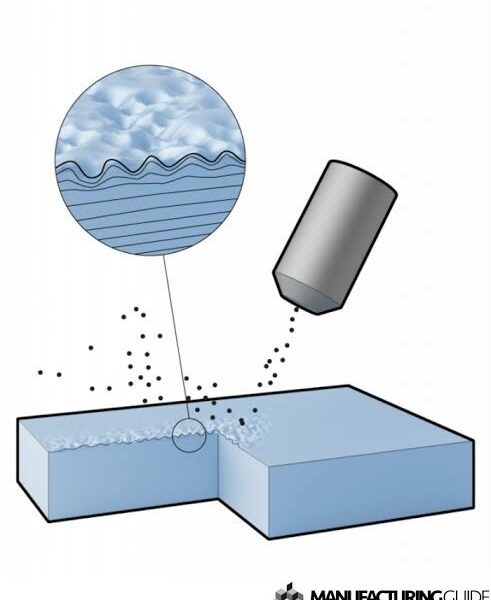Discover the benefits of shot peening and its impact on material strength. Learn what is shot peening and how does this process enhances durability and performance.
What is shot peening? Shot peening is a crucial process in manufacturing and surface engineering that plays a significant role in enhancing the durability and performance of metal components. By subjecting a material’s surface to tiny, high-velocity metal shots, shot peening induces compressive residual stresses, improving the material’s fatigue strength and resistance to cracking and corrosion. In this comprehensive guide, we will delve into the intricacies of shot peening, its scientific principles, benefits, applications, equipment requirements, and industry best practices.
Understanding the Basics: What Is Shot Peening?
At its core, shot peening is a cold working process that utilizes the impact of spherical media, typically steel, ceramic, or glass beads, to create a layer of compressive stress on the surface of a material. Unlike shot blasting, which is used for cleaning and preparing surfaces, shot peening is specifically aimed at enhancing the mechanical properties of a component. The peening process involves the controlled deformation of the material’s surface through repeated impacts, leading to work hardening and the desired residual stress profile.
How Does Shot Peening Work?
During the shot peen process, the peening media is propelled at high speeds using air pressure or centrifugal force, striking the component’s surface and creating small indentations. These indentations cause the material to plastically deform, generating localized compressive stresses while simultaneously work-hardening the surface layer. As the process continues, a network of overlapping dimples forms, imparting a beneficial compressive stress profile that counteracts tensile stresses arising during service.
Importance of Shot Peening in Component Design
Shot peening services are a critical tool in the arsenal of engineers and manufacturers for improving the fatigue life and performance of metal components subjected to cyclic loading. By introducing compressive stresses at the surface, shot peening mitigates the initiation and propagation of cracks, thereby extending the component’s operational lifespan. This technique is commonly employed in aerospace, automotive, and medical industries where component reliability and longevity are paramount.
The Science Behind Shot Peening in Manufacturing
The effectiveness of shot peening lies in its ability to induce beneficial residual stresses that counteract the detrimental tensile stresses experienced by components during operation. When a material is subjected to cyclic loading, such as bending or rotating forces, microscopic cracks can initiate and propagate, leading to premature failure. By introducing compressive residual stresses through shot peening, the material’s resistance to crack initiation and propagation is significantly enhanced.
Stress Relief Mechanism in Shot Peening
The compressive stresses generated during shot peening act as a barrier to crack propagation by creating a state of equilibrium within the material. When an external load is applied, the compressive stresses oppose the tensile stresses, reducing the effective stress intensity at the component’s surface. This phenomenon effectively increases the material’s fatigue strength and resistance to stress corrosion, making it less susceptible to premature failure.
Material Selection and Shot Peening Parameters
The success of shot peening hinges on selecting the appropriate peening media, shot size, velocity, coverage, and intensity to achieve the desired residual stress profile. Different materials and component geometries require tailored shot peening parameters to ensure optimal performance. Additionally, factors such as shot flow consistency, nozzle design, and peening coverage uniformity play a crucial role in achieving consistent and reliable results.
Benefits of Implementing Shot Peening Techniques
Shot peening offers a myriad of benefits that make it a valuable process in enhancing the mechanical properties and longevity of metal components. Some of the key advantages of implementing shot peening techniques include:
Improved Fatigue Strength
By introducing compressive residual stresses, shot peening significantly enhances a material’s resistance to fatigue failure, increasing its fatigue strength and extending its operational lifespan. Components subjected to cyclic loading, such as gears, springs, and turbine blades, benefit immensely from the fatigue-enhancing effects of shot peening.
Enhanced Wear Resistance
The work-hardened surface layer resulting from shot peening exhibits improved wear resistance, reducing the likelihood of surface damage and extending the component’s wear life. This is particularly beneficial in applications where components are subjected to abrasive wear or sliding contact, such as gears, shafts, and bearings.
Stress Corrosion Cracking Mitigation
Shot peening helps mitigate stress corrosion cracking by creating a compressive stress layer that counteracts the tensile stresses induced by corrosive environments. This is especially critical in industries such as marine, oil and gas, and chemical processing, where components are exposed to aggressive media that can lead to premature failure.
Benefits Applications Improved Fatigue Strength Aerospace Industry, Automotive Sector, Medical Device Manufacturing Enhanced Wear Resistance Aerospace Industry, Automotive Sector Stress Corrosion Cracking Mitigation Aerospace Industry, Automotive Sector, Medical Device Manufacturing
Exploring Different Applications of Shot Peening
Shot peening finds widespread applications across various industries where the enhancement of mechanical properties and surface integrity is paramount. Some of the key applications of shot peening include:
Aerospace Industry
In the aerospace sector, shot peening is used to improve the fatigue strength and damage tolerance of critical components such as landing gear, engine parts, and structural elements. By enhancing the resistance to fatigue failure and stress corrosion cracking, shot peening plays a vital role in ensuring the safety and reliability of aircraft components.
Automotive Sector
Automotive manufacturers utilize shot peening to increase the durability and longevity of components subjected to dynamic loading, such as suspension springs, transmission gears, and steering components. By enhancing the fatigue strength and wear resistance of these parts, shot peening contributes to improved performance and reliability of vehicles.
Medical Device Manufacturing
In the medical industry, shot peening is employed to enhance the mechanical properties and biocompatibility of implantable devices such as orthopedic implants and surgical instruments. By improving the fatigue strength and corrosion resistance of these components, shot peening ensures their long-term functionality and compatibility with the human body.
Choosing the Right Equipment for Effective Shot Peening
The efficacy of shot peening is contingent upon using the appropriate equipment and tools to achieve the desired surface treatment results. Key considerations when selecting shot peening equipment include:
Peening Media Selection
Choosing the right peening media, such as steel shots, ceramic beads, or glass beads, is crucial in achieving the desired surface finish and residual stress profile. The hardness, shape, and size of the peening media influence the intensity and effectiveness of the shot peening process.
Shot Peening Machines
Shot peening machines, including air blast cabinets, wheel blast machines, and automated peening systems, play a pivotal role in controlling the peening process parameters such as shot velocity, coverage, and intensity. Selecting the appropriate machine based on the component geometry and production volume is essential for achieving consistent and reliable shot peening results.
Monitoring and Quality Control
Implementing robust monitoring and quality control measures during shot peening operations is essential for ensuring the desired surface finish and residual stress distribution. Techniques such as Almen strip testing, residual stress measurement, and surface profilometry help verify the effectiveness of the shot peening process and maintain quality standards.
Industry Insights and Best Practices for Successful Shot Peening Operations
To optimize shot peening operations and achieve superior surface treatment results, adhering to industry best practices and guidelines is imperative. Some key insights and recommendations for successful shot peening operations include:
Process Optimization
Fine-tuning shot peening parameters, such as shot size, velocity, coverage, and intensity, based on the material properties and component requirements is essential for achieving the desired residual stress profile and surface finish. Continuous process optimization and monitoring help maintain consistency and repeatability in shot peening operations.
Training and Certification
Ensuring that shot peening operators and technicians receive proper training and certification in shot peening techniques and equipment operation is crucial for maintaining operational efficiency and quality standards. Well-trained personnel understand the intricacies of shot peening and can make informed decisions to optimize the process.
Compliance with Standards
Adhering to industry standards and specifications, such as AMS2430, SAE J442, and ISO 8502, ensures that shot peening processes meet regulatory requirements and deliver the desired mechanical properties and surface integrity. Compliance with standards also facilitates traceability and quality assurance in shot peening operations.
Challenges and Solutions in Shot Peening Applications
Common Challenges in Shot Peening
- Over-peening or under-peening leading to incorrect residual stress profiles.
- Inadequate coverage resulting in inconsistent surface treatment.
- Contamination of peening media affecting the quality of the process.
Solutions to Overcome Challenges
- Conducting regular process audits to ensure proper peening intensity.
- Implementing automated monitoring systems for consistent coverage.
- Maintaining strict control over peening media quality and cleanliness.
In conclusion, shot peening is a versatile and effective surface treatment process that offers numerous benefits in enhancing the mechanical properties and performance of metal components. By understanding the science behind shot peening, exploring its diverse applications, selecting the right equipment, and following industry best practices, manufacturers can harness the full potential of shot peening to improve component reliability and longevity. Incorporating shot peening techniques into manufacturing processes can lead to enhanced product quality, cost savings, and increased customer satisfaction in various industries.
For further reading and references on shot peening services and applications, refer to studies, research papers, or industry reports that delve deeper into the subject matter. Real-life examples or case studies of successful shot peening applications can provide valuable insights into the practical implementation and benefits of shot peening in different industries.








